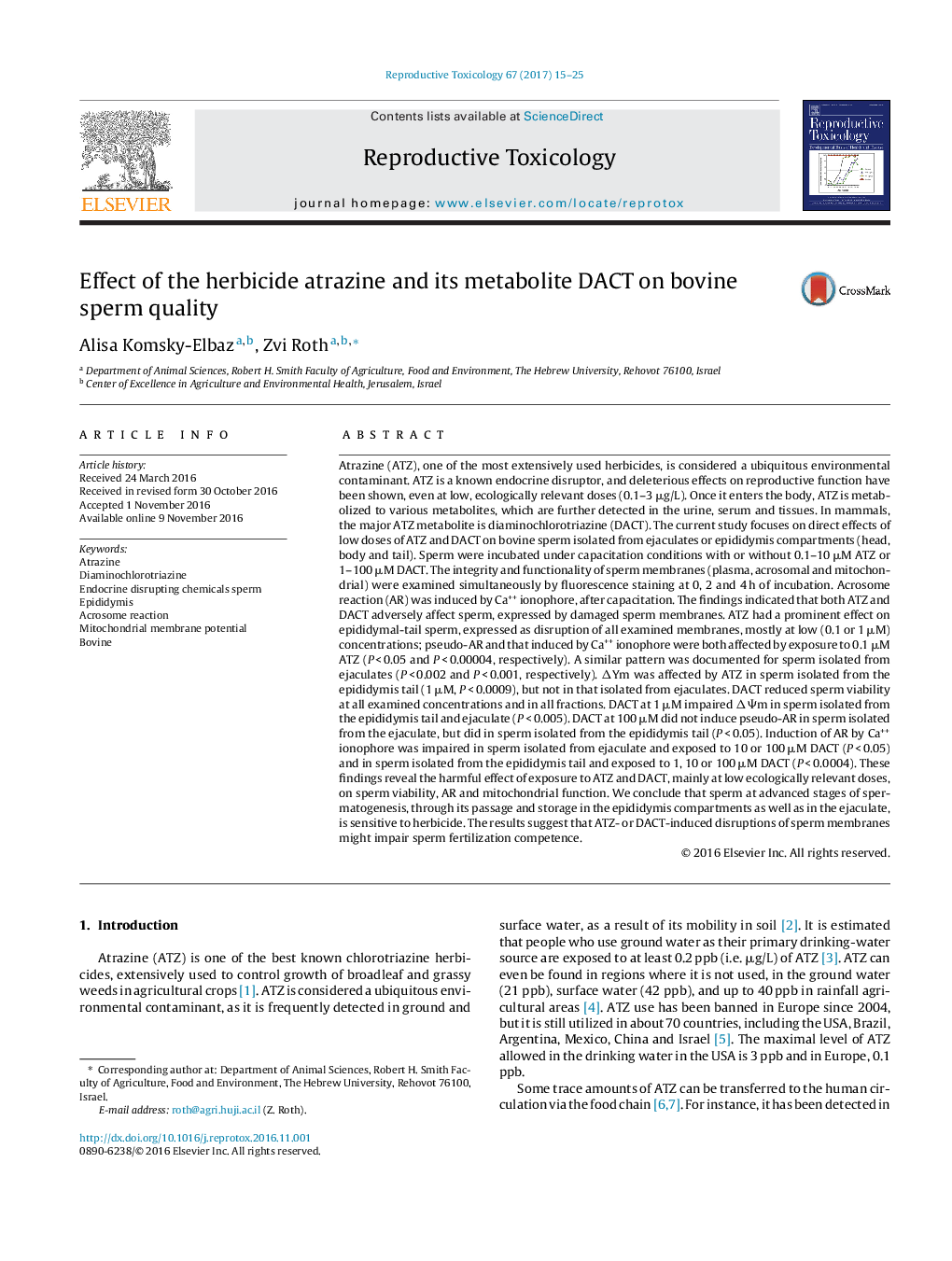| کد مقاله | کد نشریه | سال انتشار | مقاله انگلیسی | نسخه تمام متن |
|---|---|---|---|---|
| 5561656 | 1562152 | 2017 | 11 صفحه PDF | دانلود رایگان |

- Exposure to low-environmentally relevant concentrations of ATZ or its metabolite DACT impairs sperm features.
- Sperm from the epididymis tail is highly sensitive to ATZ and DACT.
- ATZ or DACT hyperpolarized the sperm mitochondrial membrane, decreased sperm viability and disrupted acrosome reaction.
Atrazine (ATZ), one of the most extensively used herbicides, is considered a ubiquitous environmental contaminant. ATZ is a known endocrine disruptor, and deleterious effects on reproductive function have been shown, even at low, ecologically relevant doses (0.1-3 μg/L). Once it enters the body, ATZ is metabolized to various metabolites, which are further detected in the urine, serum and tissues. In mammals, the major ATZ metabolite is diaminochlorotriazine (DACT). The current study focuses on direct effects of low doses of ATZ and DACT on bovine sperm isolated from ejaculates or epididymis compartments (head, body and tail). Sperm were incubated under capacitation conditions with or without 0.1-10 μM ATZ or 1-100 μM DACT. The integrity and functionality of sperm membranes (plasma, acrosomal and mitochondrial) were examined simultaneously by fluorescence staining at 0, 2 and 4 h of incubation. Acrosome reaction (AR) was induced by Ca++ ionophore, after capacitation. The findings indicated that both ATZ and DACT adversely affect sperm, expressed by damaged sperm membranes. ATZ had a prominent effect on epididymal-tail sperm, expressed as disruption of all examined membranes, mostly at low (0.1 or 1 μM) concentrations; pseudo-AR and that induced by Ca++ ionophore were both affected by exposure to 0.1 μM ATZ (P < 0.05 and P < 0.00004, respectively). A similar pattern was documented for sperm isolated from ejaculates (P < 0.002 and P < 0.001, respectively). ÎYm was affected by ATZ in sperm isolated from the epididymis tail (1 μM, P < 0.0009), but not in that isolated from ejaculates. DACT reduced sperm viability at all examined concentrations and in all fractions. DACT at 1 μM impaired ÎΨm in sperm isolated from the epididymis tail and ejaculate (P < 0.005). DACT at 100 μM did not induce pseudo-AR in sperm isolated from the ejaculate, but did in sperm isolated from the epididymis tail (P < 0.05). Induction of AR by Ca++ ionophore was impaired in sperm isolated from ejaculate and exposed to 10 or 100 μM DACT (P < 0.05) and in sperm isolated from the epididymis tail and exposed to 1, 10 or 100 μM DACT (P < 0.0004). These findings reveal the harmful effect of exposure to ATZ and DACT, mainly at low ecologically relevant doses, on sperm viability, AR and mitochondrial function. We conclude that sperm at advanced stages of spermatogenesis, through its passage and storage in the epididymis compartments as well as in the ejaculate, is sensitive to herbicide. The results suggest that ATZ- or DACT-induced disruptions of sperm membranes might impair sperm fertilization competence.
Journal: Reproductive Toxicology - Volume 67, January 2017, Pages 15-25